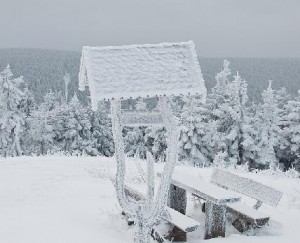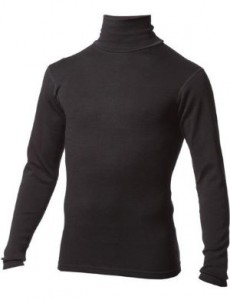So you want to stay warm when everyone else (those not as smart as you, that is) are freezing their behinds off? Staying warm when the temperature drops down to where you think your fingers are going to fall off can be a challenge, but the good news is that there’s a few tricks that you can (and should) implement – both for your comfort and your safety.
Gearing up for the winter season is not something to take lightly, and every piece of clothing you wear should be carefully selected. It doesn’t really matter whether you have somewhere to warm up when you’re out on duty – you

should always dress as if you don’t. Having a vehicle for shelter is only good for something when the motor’s running – you have to consider a situation where that motor can’t help you, for whatever reason.
Your body doesn’t like cold – that’s just the way it is. It’s going to have all sorts of reactions to cold weather, and the reactions will vary from person to person. Most people will burn more calories, and you’ll get hungry. If you don’t eat enough, you’ll get even colder, but that has little to do with your gear. Let’s look at what you might need in order to stay warm, and to get warm again if your body temperature has gotten a chance to drop too low for comfort.
Your “unmentionables” need to be up to speed – starting with the bottom layer is just another reminder to yourself that nothing you wear out into the cold should be on you by chance. Everything needs to be considered and picked especially for the task – or you’ll be the one to suffer.
Wool.
It’s the best thing ever invented, and despite what most producers of synthetic materials tell you, there’s no way to beat natural wool. In most cases, it’s the only thing that can keep you warm, and that still breathes. Another point to consider is that wool is the only material that will still insulate when you’re wet, be it from sweating or from taking a sudden dip into water.
Wool blends.
Well… there are some that are good, and some that are not. A good “rule of thumb” for this is to check percentages. The higher the percentage of wool, the better – it’s not open to debate. In socks and other underwear you’ll

probably find it more comfortable if there’s some elastic materials blended in with the wool, to make sure the clothing fits right, stays in place and doesn’t lose its shape. Just to be clear about this – the wool percentage needs to be higher than whatever it’s been mixed with – preferrably in the 80/20 or 70/30 range – the wool percentage should under no circumstance drop below 70 percent.
There’s one last point about wool that should be mentioned, and that is the several types of wool out there. You should look for Merino wool, a softer wool than some others, making it more comfortable to wear, and much less itchy.
Outer garments, and everything else.
You’ve got to have something more than just long johns in order to be presentable, they say, so it’s only appropriate that we include something about that here.
Let’s go from the bottom. Your feet are going to be your enemies all winter long. Always in contact with the cold, cold ground, your feet will be exposed to the highest risk of freezing, damage due to cold, and they’re the parts of you – in a close race with your fingers – which are going to be on your mind the most. There’s a few things that you can do, however, in order to minimize that on-the-mind time.
Socks.
Again, it’s wool. Wool, wool, wool. Thick wool (pure wool) socks are your only friends out in sub zero temperatures, and even then they’re only effective if you do everything else down there right as well.
Along with the socks, you’re going to need shoes that are big enough fit your feet, your thick socks, a pair of insoles made of what is known as “vadmel”, a hard packed wool that will insulate and stay dry, or something like this. Having boots that are 1-1,5 sizes larger than you usually wear is your best route. This will also leave your feet room to move inside all that wool, and that is essential. Without room to move, you won’t have enough room for the air your feet warms up to stay warm, and you’ll eventually end up being cold no matter what.
Remember to not tie your 8″-10″ boots too tight either – you want to keep your blood flowing freely down to your feet, keeping up the heat exchange between your extremities and your warmer core.
Pants.
Wind-proofing is key here. A sturdy material that won’t rip or let the air through is what you should go for – remember that this doesn’t have to be very thick, it just needs to make sure the air between the fabric and your leg isn’t moving too much – moving air is cold, while air staying still has a chance to get warmed up. If it’s not too cold or wet outside, you can go with something like the 5.11 Tactical TDU pants. If it’s too cold for those, you should go with something insulated, preferrably with down, not with synthetic fibres.
Core – torso and neck.

The main thing here is insulating from the inside out – i.e. wear wool closest to your skin – no cotton t-shirts, please! Adding layers is important, just as it was on your legs, and you should always aim for at least three layers to make sure that your core and torso stays warm. As long as your torso is warm, bloodflowing to your legs and feet will make sure those stay warm as well.
Wool sleeved undershirt, then a wool blend long sleeved turtleneck, then a NATO wool sweater and then your duty jacket or other insulated jacket will make sure you stay warm every time. If you still feel chilly, add another wool undershirt – this way, you’ll still be mobile, and one of those will insulate just as well as another jacket, with only a fraction of the bulk.
Your neck will be covered by a turtleneck, of course, but that’s not always enough. A neck warmer made of wool is the best bet you have, and top that off with a wool cap or hat, and you’re good to go almost anywhere, in any temperature when the numbers are in the blue.
But… what EXACTLY should I wear?
We’re here to help you with that. On this page – we’ll tell you exactly what we like – and have tried and tested. As usual, let us know if you have tips or tricks of your own! Leave a comment or send us an email!

1 thought on “Gearing Up For Winter – How To Stay Cozy in Teeth-Chattering Cold”